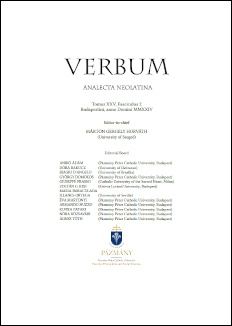Un viaggio teatrale attraverso i secoli: Un episodio mediceo secondo il Lorenzaccio di Alfred de Musset e nell’interpretazione di Victor Ioan Frunză a Timisoara del 1998
Published 31-12-2024
Keywords
- Italian theatre,
- Renaissance Florence,
- Medici,
- Alfred de Musset,
- French Romanticism,
- Timisoara,
- Hungarian and Romanian theatre
How to Cite
Copyright (c) 2025 Nóra Sediánszky

This work is licensed under a Creative Commons Attribution 4.0 International License.
Abstract
Alfred de Musset is one of the daredevils of French Romanticism and one of the most exciting and individual figures of the 19th century. His play is a fascinating reflection of the traditions and historical scene of the Medici period, with the language and spirit of romantic theatre. Musset reads the assassination of Alessandro de’ Medici and the story of Lorenzaccio as a representation of the inner nature of rebellion and as a romantic paraphrase of William Shakespeare’s Hamlet. My lecture will explore how the political and love scene of the Medici era appears in the Romantic and French interpretation of Musset, and will examine the visions of one of the most important directors of our time, the Romanian Ioan Victor Frunză. I am especially interested in how different cultures interpret the Medici period, and how the language of art and the ways of thinking can connect different societies, groups and people.
References
- Bromfield, J. G. (1972): De Lorenzino de Médicis à Lorenzaccio: étude d’un thème historique. Paris: Didier.
- Coelho de Araújo, I. (2010): Une étude sur ‘Lorenzaccio’ d’A. de Musset. Revista Letras 14. http://dx.doi.org/10.5380/rel.v14i0.19852
- Dall’Aglio, S. (2011): L’assassino del duca. Esilio e morte di Lorenzino de’ Medici. Firenze: L. S. Olschki.
- Darvay Nagy, A. (2012): A fekete herceg (Le Duc maure) [Ducele Negru]. https://andrasdemeter.blogspot.com/2012/09/evfordulok-hatarkovek-2012-198725-2012.html
- de Medici, L. (2005): L’Aridosia. Édition bilingue français-italien, Les Belles Lettres.
- de Musset, A. (2012): Lorenzaccio. Paris: Larousse.
- Giannetti, S. & V. Giannetti (2019): I Medici. Firenze: Pontecorboli.
- Mamone, S. (1981): Il teatro nella Firenze medicea, Milano: Mursia.
- Mamone, S. (2015): Drammaturgia di macchine nel teatro granducale fiorentino. Il teatro degli Uffizi da Buontalenti ai Parigi. Drammaturgia 12(2): 17–43. https://doi.org/10.13128/Drammaturgia-18359
- Morin, E. (2021): Leçons d’un siècle de vie. Paris: Denoël.
- Naugrette, F. (2001): Le théâtre romantique: histoire, écriture, mise en scène. Paris: Éditions du Seuil.
- Pichot, C. (2002): Une Conspiration en 1537. George Sand. http://george.sand.pagesperso-orange.fr/FL1.html
- Sand, G. (1998): Une conspiration, 1537. Paris: Pocket.
- Tombi, B. (2020): Fra scienza e teatro: Leonardo da Vinci scenografo di Ludovico il Moro. Nuova Corvina 32: 182–191.


